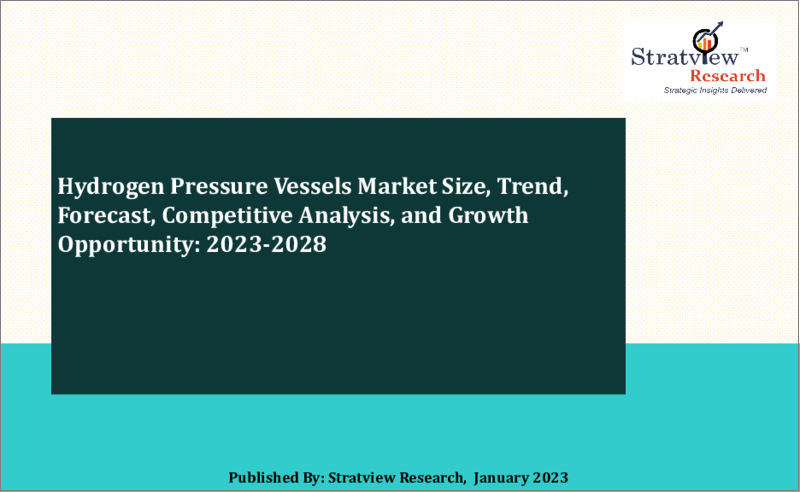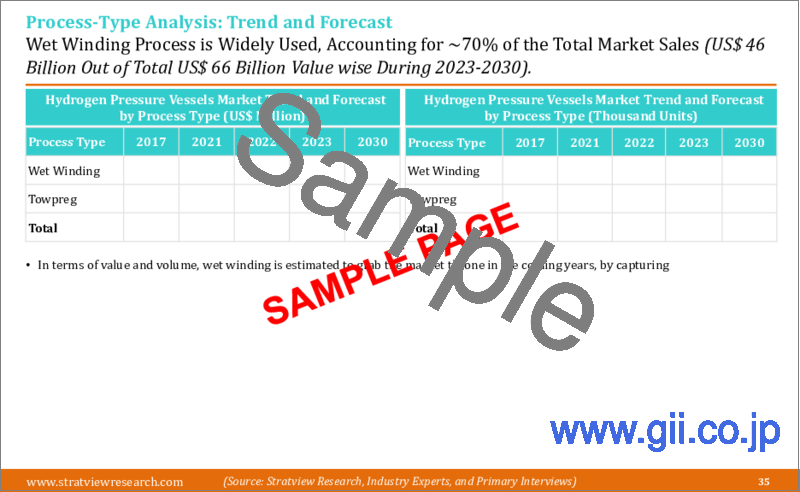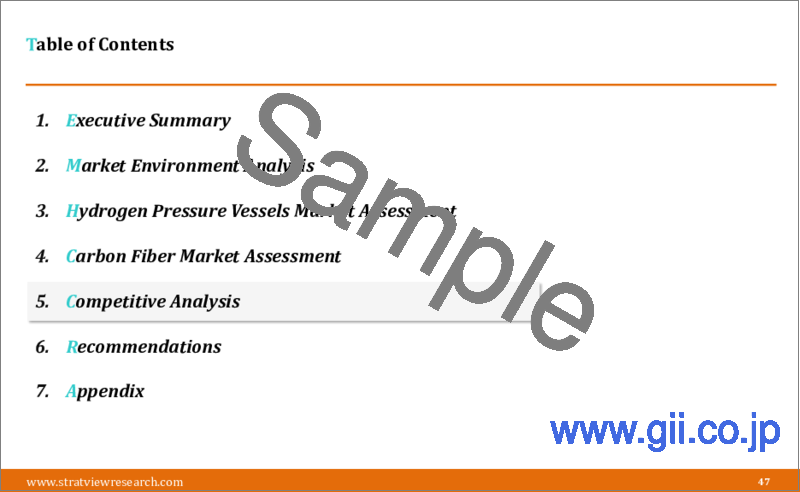|
|
市場調査レポート
商品コード
1224462
水素圧力容器の世界市場 (2023-2030年):市場規模・シェア・動向・予測・競合分析・成長機会Hydrogen Pressure Vessels Market Size, Share, Trend, Forecast, Competitive Analysis, and Growth Opportunity: 2023-2030 |
||||||
| 水素圧力容器の世界市場 (2023-2030年):市場規模・シェア・動向・予測・競合分析・成長機会 |
|
出版日: 2023年02月18日
発行: Stratview Research
ページ情報: 英文 113 Pages
納期: 即日から翌営業日
|
- 全表示
- 概要
- 目次
水素圧力容器は、輸送用燃料電池の電源として利用されることが多くなっています。使用後に放電する電池とは異なり、燃料があれば電気を供給できるため、電池よりも大きな利点があります。燃料電池自動車(FCEV)事業は、現状では非常にニッチな分野ではあるものの、ここ数年で飛躍的な成長を遂げており、今後大きく発展する可能性があります。
世界の水素圧力容器の市場規模は、50.9%のCAGRで非常に高い成長率を示し、2030年には198億米ドルの規模に成長すると予測されています。
当レポートでは、世界の水素圧力容器の市場を調査し、市場概要、COVID-19およびその他の市場影響因子の分析、市場規模の推移・予測、各種区分・地域別の内訳、競合環境、主要企業のプロファイル、成長機会の分析などをまとめています。
目次
第1章 エグゼクティブサマリー
第2章 水素圧力容器市場:環境分析
- サプライチェーン分析
- PEST分析
- 産業ライフサイクル分析
- 市場促進要因
- 市場の課題
第3章 水素圧力容器市場:市場評価
- 圧力容器市場全体における水素圧力容器のシェア
- 水素圧力容器市場の動向・予測
- 市場シナリオ分析:さまざまな市場環境における成長の軌跡
- 各種区分別の分析:動向・予測
- 容器別
- 用途別
- プロセス別
- 地域分析
第4章 炭素繊維複合材料市場の評価
- 水素圧力容器の炭素繊維のバリューチェーン分析
- 主要な炭素繊維および樹脂のサプライヤー
- 水素圧力容器向け炭素繊維市場の動向・予測
第5章 競合分析
- 市場統合レベル
- 競合情勢
- 主要な水素圧力容器製造業者に関する重要な情報
- 戦略的提携
- 地域的プレゼンス
- ポーターのファイブフォース分析
第6章 戦略的成長機会
- 市場の魅力分析
- 戦略的影響
- 新たな動向
- 主な成功要因
第7章 主要企業のプロファイル
- Faurecia
- Hanwha Solutions
- Hexagon Purus
- Iljin Hysolus CO., LTD
- Luxfer Gas Cylinders
- NPROXX
- Plastic Omnium
- TEIJIN LIMITED
- TOYODA GOSEI Co., Ltd.
- TOYOTA MOTOR CORPORATION
第8章 付録
Market Insights
Hydrogen pressure vessels are increasingly utilized for powering fuel cells that are used for transportation purposes. They offer significant advantages over batteries as they can supply electricity if there is source fuel available, unlike batteries that can discharge after usage. Although the overall fuel cell electric vehicle (FCEV) business is very niche currently, it has been witnessing tremendous growth in recent years and is likely to flourish significantly in the coming years.
In recent years, there has been an increased usage of hydrogen pressure vessels in the transportation industry, owing to growing traction toward alternative fuel vehicles. The long-term scenario seems to be extremely fruitful with a plethora of opportunities for all the players involved in the entire supply chain of hydrogen pressure vessels. In addition, the Zero-Emission Vehicle (ZEV) regulations of various countries, increasing investments in the deployment of hydrogen infrastructure, and production upsurge of various FCEVs including passenger cars are the key factors, likely to escalate the market demand during the forecast period.
Moreover, the increasing focus on the deployment of hydrogen pipelines, liquefaction plants, storage facilities, compressors, and dispensers is also expected to significantly influence market growth in the coming years. Governments all over the world have stepped up their efforts to reduce greenhouse gas emissions by encouraging the construction of hydrogen stations that use less energy is also a major reason for increasing hydrogen demand across the regions. Overall, it is expected that the hydrogen pressure vessels market would grow at a whopping CAGR of 50.9%, reaching US$ 19.8 billion in 2030.
Recent Market JVs and Acquisitions:
There have been a fair number of strategic alliances including M&As, JVs, etc. performed over the past few years. Some of them have been mentioned below:
- In October 2022, Hexagon Purus and Lhyfe collaborated on the distribution of green and renewable hydrogen in Europe.
- In August 2022, Hexagon Purus entered into an agreement to acquire 40% shares of Cryoshelter's liquid hydrogen business. Following the acquisition, the two companies are expected to develop liquid hydrogen technology in the coming years.
- In October 2021, Plug Power Inc. acquired Applied Cryo Technologies, Inc., a provider of technology, equipment, and services for the transportation, storage, and distribution of liquefied hydrogen along with other cryogenic gases. This acquisition would help Plug Power Inc. expand its green hydrogen ecosystem and reduce the cost of hydrogen infrastructure and logistics networks.
- In September 2021, Hexagon Purus entered into an agreement to acquire 100% shares of Wystrach GmbH. This acquisition is likely to strengthen the capabilities of Hexagon Purus w.r.t the product offerings for hydrogen storage solutions and simultaneously increase its market share.
- In June 2020, Cummins Inc. had an agreement to form a joint venture with NPROXX, to provide customers with hydrogen and CNG storage products for on-highway and rail applications.
- In December 2020, Hanwha Solutions acquired 100% shares of Cimarron Composites, an American high-pressure vessel manufacturer. This acquisition would accelerate the expansion of Hanwha Solutions into the green-hydrogen industry.
- Based on the vessel type, the market is segmented into type-III vessels and type-IV vessels. Between vessel types, type-IV vessel is expected to maintain their market dominance during the forecast period. The key advantages offered by type-IV vessels are weight reduction, corrosion-free, fatigue resistance, high storage density, and low operational cost. These vessels are highly used in mobility applications and are used across key FCEV models such as Toyota Mirai, Hyundai Nexo, and EUNIQ 7.
- Based on the application type, the market is classified as mobility and gas storage and distribution. Between the two application types, mobility is likely to account for the undeniable market dominance during the forecast period, due to the rising production of FCEVs. Gas storage & distribution is also likely to record exceptional growth in the coming years.
- Based on the process type, the market is segmented into the wet winding process and the towpreg process. In the coming years, towpreg process is likely to gain more acceptance, propelled by several factors including but not limited to clean processing, improved part quality, fast winding speeds, and short cure cycles. Despite some shifts towards towpreg process, wet winding is likely to remain the most widely used manufacturing process in the year to come.
- In terms of regions, Asia-Pacific is expected to remain the largest market for hydrogen pressure vessels during the forecast period. The region is home to major FCEV OEMs, such as Hyundai Motor Company and TOYOTA MOTOR CORPORATION, which are expected to drive the regional market demand in the coming years. In addition to this, the active presence of hydrogen pressure vessels manufacturing companies, such as ILJIN Hysolus CO., LTD, TOYOTA MOTOR CORPORATION, and TOYODA GOSEI Co., Ltd., is likely to significantly influence the regional market growth during the forecast period.
- Key Players
- The market is currently consolidated with the presence of a handful of players. Most of the major companies have exceptional product development capabilities. They focus on increasing their vessel production capacity to keep up with the rising production of FCEVs. These companies primarily produce type-IV vessels and have an active presence in mobility, gas storage, and distribution applications. However, as the market is relatively tiny currently, the competition is likely to evolve in the coming years, with the entry of new players in the market. The following are the key players in the hydrogen pressure vessels market.
- Iljin Hysolus CO., LTD
- Hexagon Purus
- Luxfer Gas Cylinders
- TOYOTA MOTOR CORPORATION
- Plastic Omnium
- Faurecia
- TOYODA GOSEI Co., Ltd.
- Hanwha Solutions
- TEIJIN LIMITED
- NPROXX
- Research Methodology
- This strategic assessment report, from Stratview Research, provides a comprehensive analysis that reflects today's hydrogen pressure vessels market realities and future market possibilities for the forecast period. The report segments and analyzes the market in the most detailed manner in order to provide a panoramic view of the market. The vital data/information provided in the report can play a crucial role for the market participants as well as investors in the identification of the low-hanging fruits available in the market as well as to formulate the growth strategies to expedite their growth process.
- This report offers high-quality insights and is the outcome of a detailed research methodology comprising extensive secondary research, rigorous primary interviews with industry stakeholders, and validation and triangulation with Stratview Research's internal database and statistical tools. More than 1,000 authenticated secondary sources, such as company annual reports, fact books, press releases, journals, investor presentations, white papers, patents, and articles, have been leveraged to gather the data. We conducted more than 10 detailed primary interviews with the market players across the value chain in all four regions and industry experts to obtain both qualitative and quantitative insights.
- Report Features
This report provides market intelligence in the most comprehensive way. The report structure has been kept such that it offers maximum business value. It provides critical insights into the market dynamics and will enable strategic decision-making for the existing market players as well as those willing to enter the market. The following are the key features of the report:
- Market structure: Overview, industry life cycle analysis, supply chain analysis.
- Market environment analysis: Growth drivers and constraints, Porter's five forces analysis, SWOT analysis.
- Market trend and forecast analysis.
- Market segment trend and forecast.
- Competitive landscape and dynamics: Market share, Product portfolio, New Product Launches, etc.
- COVID-19 impact and its recovery curve
- Attractive market segments and associated growth opportunities.
- Emerging trends.
- Strategic growth opportunities for the existing and new players.
- Key success factors.
- The hydrogen pressure vessels market is segmented into the following categories.
- Hydrogen Pressure Vessels Market, by Vessel Type
- Type-III Vessel (Trend and Forecast)
- Type-IV Vessel (Trend and Forecast)
- Hydrogen Pressure Vessels Market, by Application Type
- Mobility (Trend and Forecast)
- LV (Trend and Forecast)
- MHDV (Trend and Forecast)
- Others (Trend and Forecast)
- Gas Storage and Distribution (Trend and Forecast)
- Hydrogen Storage (Trend and Forecast)
- Stationary Refueling (Trend and Forecast)
- Mobile Refueling (Trend and Forecast)
- Hydrogen Pressure Vessels Market, by Process Type
- Towpreg Process (Trend and Forecast)
- Wet Winding Process (Trend and Forecast)
- Hydrogen Pressure Vessels Market, by Region
- North America (Country Analysis: The USA and Rest of North America)
- Europe (Country Analysis: Germany, Italy, Norway, and Rest of Europe)
- Asia-Pacific (Country Analysis: Japan, China, South Korea, and the Rest of Asia-Pacific)
- Rest of the World (Country Analysis: Latin America and Others)
Table of Contents
- Report Scope
- Report Objectives
- Research Methodology
- Market Segmentation
- Secondary Research
- Key Information Gathered from Secondary Research
- Primary Research
- Key Information Gathered from Primary Research
- Breakdown of Primary Interviews by Region, Designation, and Value Chain Node
- Data Analysis and Triangulation
1. Executive Summary
2. Hydrogen Pressure Vessels Market Environment Analysis
- 2.1. Supply Chain Analysis
- 2.2. PEST Analysis
- 2.3. Industry Life Cycle Analysis
- 2.4. Emerging Trends
- 2.5. Market Drivers
- 2.6. Market Challenges
3. Hydrogen Pressure Vessels Market Assessment (2017-2030) (US$ Million and Thousand Units)
- 3.1. Contribution of Hydrogen Pressure Vessels in the Total Pressure Vessels Market
- 3.2. Hydrogen Pressure Vessels Market Trend and Forecast (US$ Million and Thousand Units)
- 3.3. Market Scenario Analysis: Growth Trajectories in Different Market Conditions
- 3.4. Market Segment Analysis: Trend and Forecast (US$ Million and Thousand Units)
- 3.4.1. Vessel-Type Analysis
- 3.4.1.1. Type-III Vessel: Trend and Forecast (US$ Million and Thousand Units)
- 3.4.1.2. Type-IV Vessel: Trend and Forecast (US$ Million and Thousand Units)
- 3.4.2. Application-Type Analysis
- 3.4.2.1. Mobility: Trend and Forecast (US$ Million and Thousand Units)
- 3.4.2.1.1. LV: Trend and Forecast (US$ Million and Thousand Units)
- 3.4.2.1.2. MHDV: Trend and Forecast (US$ Million and Thousand Units)
- 3.4.2.1.3. Others: Trend and Forecast (US$ Million and Thousand Units)
- 3.4.2.2. Gas Storage and Distribution: Trend and Forecast (US$ Million and Thousand Units)
- 3.4.2.2.1. Hydrogen Storage: Trend and Forecast (US$ Million and Thousand Units)
- 3.4.2.2.2. Stationary Refueling: Trend and Forecast (US$ Million and Thousand Units)
- 3.4.2.2.3. Mobile Refueling: Trend and Forecast (US$ Million and Thousand Units)
- 3.4.3. Process-Type Analysis
- 3.4.3.1. Towpreg Process: Trend and Forecast (US$ Million and Thousand Units)
- 3.4.3.2. Wet Winding Process: Trend and Forecast (US$ Million and Thousand Units)
- 3.4.4. Regional Analysis
- 3.4.4.1. North American Hydrogen Pressure Vessels Market: Country Analysis
- 3.4.4.1.1. The USA's Hydrogen Pressure Vessels Market T&F (US$ Million and Thousand Units)
- 3.4.4.1.2. Rest of North American Hydrogen Pressure Vessels Market T&F (US$ Million and Thousand Units)
- 3.4.4.2. European Hydrogen Pressure Vessels Market: Country Analysis
- 3.4.4.2.1. German Hydrogen Pressure Vessels Market T&F (US$ Million and Thousand Units)
- 3.4.4.2.2. Italian Hydrogen Pressure Vessels Market T&F (US$ Million and Thousand Units)
- 3.4.4.2.3. Norwarian Hydrogen Pressure Vessels Market T&F (US$ Million and Thousand Units)
- 3.4.4.2.4. Rest of the European Hydrogen Pressure Vessels Market T&F (US$ Million and Thousand Units)
- 3.4.4.3. Asia-Pacific's Hydrogen Pressure Vessels Market: Country Analysis
- 3.4.4.3.1. Chinese Hydrogen Pressure Vessels Market T&F (US$ Million and Thousand Units)
- 3.4.4.3.2. Japanese Hydrogen Pressure Vessels Market T&F (US$ Million and Thousand Units)
- 3.4.4.3.3. South Korean Hydrogen Pressure Vessels Market T&F (US$ Million and Thousand Units)
- 3.4.4.3.4. Rest of the Asia-Pacific's Hydrogen Pressure Vessels Market T&F (US$ Million and Thousand Units)
- 3.4.4.4. Rest of the World's (RoW) Hydrogen Pressure Vessels Market: Country Analysis
- 3.4.4.4.1. Latin American Hydrogen Pressure Vessels Market T&F (US$ Million and Thousand Units)
- 3.4.4.4.2. Others Hydrogen Pressure Vessels Market T&F (US$ Million and Thousand Units)
- 3.4.1. Vessel-Type Analysis
4. Carbon Fiber Composites Market Assessment
- 4.1. Carbon Fiber Value Chain Analysis for Hydrogen Pressure Vessels
- 4.2. Major Carbon Fiber and Resin Suppliers
- 4.3. Carbon Fiber Market Trend and Forecast for Hydrogen Pressure Vessel
5. Competitive Analysis
- 5.1. Product Portfolio Analysis
- 5.2. Market Share Analysis
- 5.3. Competitive Landscape
- 5.4. Key Information on the Major Hydrogen Pressure Vessel Manufacturers
- 5.5. Strategic Alliances
- 5.6. Geographical Presence
- 5.7. Porter's Five Forces Analysis
6. Strategic Growth Opportunities
- 6.1. Market Attractiveness Analysis
- 6.1.1. Market Attractiveness by Vessel Type
- 6.1.2. Market Attractiveness by Application Type
- 6.1.3. Market Attractiveness by Process Type
- 6.1.4. Market Attractiveness by Region
- 6.1.5. Market Attractiveness by Country
- 6.2. Strategic Implications
- 6.3. Emerging Trends
- 6.4. Key Success Factors (KSFs)
7. Company Profile of Key Players (Alphabetically Arranged)
- 7.1. Faurecia
- 7.2. Hanwha Solutions
- 7.3. Hexagon Purus
- 7.4. Iljin Hysolus CO., LTD
- 7.5. Luxfer Gas Cylinders
- 7.6. NPROXX
- 7.7. Plastic Omnium
- 7.8. TEIJIN LIMITED
- 7.9. TOYODA GOSEI Co., Ltd.
- 7.10. TOYOTA MOTOR CORPORATION
8. Appendix
- 8.1. Disclaimer
- 8.2. Copyright
- 8.3. Abbreviation
- 8.4. Currency Exchange
- 8.5. Market Numbers




